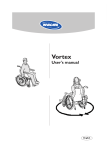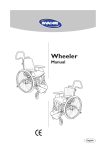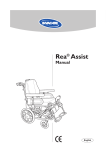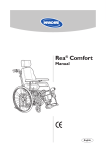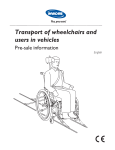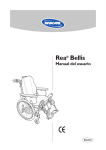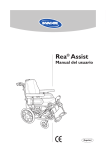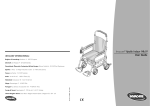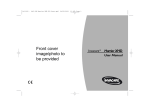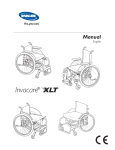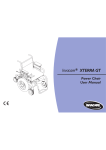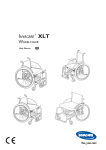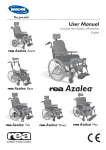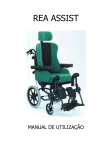Download Rea® Bellis
Transcript
Rea® Bellis Manual English Rea® Bellis Rea® Bellis is a wheelchair with many adjustment options and accessories. To ensure that you benefit as much as possible from Rea® Bellis, and in order to do its options justice, the chair must be tested and adjusted by competent personnel. We hope that you have also received instructions for using your Rea Bellis in everyday life. This manual includes a description of the parts of the chair, simple adjustment options, how to use the Rea® Bellis safely and how to transport it. The manual must be read thoroughly before the chair is used. Also included in this manual is a description of how all accessories are fitted and slightly more advanced settings. As the Rea® Bellis has many different components and accessories, the appearance of the accessories you have for your chair may differ from those shown. NB! ! Read the back cover of this user’s manual, which features a number of points affecting your personal safety. Read it carefully! Invacare is only responsible for product changes carried out by personnel who we authorise. We reserve the right to make any changes to equipment and specifications without prior notice. Delivery check Check that all components match the delivery note. Any transport damage must be reported immediately to the transport company. Remember to keep the packaging until the transport company has checked the goods and a settlement has been reached. 2 REA® BELLIS Contents Parts of the wheelchair Standard equipment Upholstery and frame colours Accessories Technical data – Rea Bellis Assembly Adjustments Seat Legrests/footrests Footplates/calf pads Central footplate Backrest Armrests Seat unit Manual chair with gas piston Electrically operated chair Rear wheels Wheelchair heights Frame extension Brake Carer-operated brake Push handles/push bar Anti-tip device Transport Transport of wheelchairs in vehicles Observations Restraint methods Safety instructions/propelling techniques Product description Application Guarantee REA® BELLIS 4 5 5 5 6 7 9–20 9 10 10 11 13 13 14 14 15 16 17 18 18 19 19 20 21–24 23 24 25 26 28 28 29 3 Parts of the wheelchair 10 4 8 6 11 5 7 2 1 3 9 1. 2. 3. 4. 5. 6. 7. 8. 9. 10. 11. Backrest Push bar Armrest Rear wheel Rear wheel plate Anti-tip device Brake Castor Seat Legrest/Footrest Foot plate Lifting the wheelchair Only lift by the frame of the chair (as shown in the diagram).This applies at all times, irrespective of whether when the user is or is not seated in the chair. Never lift the chair by the removable armrests or by the footrests. Ensure that the backrest and push bar are properly secured. 4 REA® BELLIS Standard equipment Seat width: 39*– 41– 43* cm 44*– 46– 48* cm 49*– 51– 53* cm Seat depth: 40–52 cm * with flip-up armrests (Nice) Upholstery and frame colours Upholstery: Green plush, "Strix" Bordeaux plush Grey dartex Frame colours: Dark blue RAL5013 Bordeaux CRED 2 Accessories The Rea® Bellis has a wide range of accessories and options. Some of the accessories may not be available in certain countries. REA® BELLIS Backrest Standard Adjustable backrest Seat Standard Seat cushions Mistral Seat and backrest angle adjustment Carer-operated Electrical operated by carer/user Legrests Legrests (angle-adjustable) Amputee legrests Footrests Fixed footplate Angle-adjustable and depth-adjustable Foot plate extender Heel strap Castors 120–200 mm, pneumatic or solid, wide or narrow Rear wheels 16", 20", 22", 24", pneumatic or puncture-proof Vortex operating unit Brakes Carer-operated User brake One-arm brake Foot brake 5 Others Several types of hand rim Several types of spoke guard Reflectors Kit Table Tray Pump Cane holder Bag Headrest Neckrest Push bar Push handles brace Pelvic Belt Abduction cushion Incontinence cover Technical data – Rea® Bellis 41, 46, 51 cm 40 –52 cm 36 – 48,5 cm 52+7 cm 23–33 cm 29–51 cm -1°–+15° SW + 20,5 cm 110 cm 92–104 cm 32 kg max 125 kg* transport weight 20 kg Tie down point** * Maximum user weight is 100 kg if the chair is fitted with 100–120 mm castors. **Our wheelchairs comply over and above ISO normal standards plus ISO 10542, which have additional features providing increased levels of occupant security and safety whilst travelling in a motor vehicle.Wheelchair users should however transfer to the vehicle seat and use the vehicle installed restraint system whenever it is feasible. 6 REA® BELLIS Assembly 1. 1. Backrest The backrest is fitted by angling it upwards out of the seat and then inserting it into the attachment as shown in the diagram. ! 2. Ensure that it “clicks” into the attachment securely. 2. Armrests Fit the armrests by pushing the two tubes into the holes on the armrest holder. The armrest is then pushed down into the attachment (A). A 3a. 3. Legrests/footrests The wheelchair can be equipped with either legrests or footrests. 3a Legrests Attach the legrests by pushing the tube at the upper part of the legrests down into the tubes on the wheelchair. You must angle the legrests outwards when inserting them. Lock the legrests by turning them inwards. The legrests are automatically locked so there is no risk of them coming off the wheelchair. REA® BELLIS 7 3b. 3b Footrests Attach the footrests by pushing the tube at the upper part of the footrests down into the tubes on the wheelchair. You must angle the footrests outwards when inserting them. Lock the footrests by turning them inwards. The footrests are automatically locked so there is no risk of them coming off the wheelchair. 4. 4. Rear wheel The rear wheel is fitted by pressing button (B) in the middle of the hub and keeping it pressed in whilst inserting the axle into the rear wheel attachment (C). It is important that the wheel is fitted into place correctly and that the lock catch (D) really has locked the wheel securely. D ! B It is very important that you check that the locking pin has actually locked the wheel into position when the centre button has been released. Take hold of the wheels and try to detach them. This should NOT be possible. C 8 REA® BELLIS Adjustments SEAT 1. 1. Seat plate The Rea Bellis has an anatomically designed seat plate to provide proper stability and very good seating comfort. 2. 2. Seat depth Loosen the two screws at the legrest attachment with a 5-mm Allen key and adjust the seat depth to the desired position. Then retighten the screws. Tools: 5 mm Allen Key A 3. Tools: 4 mm Allen Key REA® BELLIS 3. Seat width The width of the seat is adjusted by moving the side supports. Pull the upholstery carefully to one side. Loosen the two screws (A) with a 4-mm Allen key and move the side supports to the desired position. There are three positions: position 1 creates a narrower chair and position 3 creates a wider chair. 9 FOOTRESTS/LEGRESTS It is important to adjust the legrests, footrests and calf pads to obtain a good seating position. 1–2. 1. Legrests height adjustment Adjust the height of the legrests by loosening the screw (A) one turn with an Allen key. Pull the legrest until you have obtained the correct height and the screw is caught by one of the recesses on the legrest tube. Then retighten screw. 2. Legrests angle adjustment The angle of the legrest is adjusted using the handwheel (B). Loosen the handwheel approx. one turn. The angle can be set in intervals from 80° to 0°. Retighten the handwheel when the correct angle is obtained. The distance between the lowest part of the footrest and the surface must be at least 40 mm. B A Tools: 5 mm Allen Key 3. 3. Footrests height adjustment Adjust the height in the same way as the legrests above. NOTE! Don't touch the upper screw (C). C The distance between the lowest part of the footrest and the surface must be at least 40 mm. A Tools: 5 mm Allen Key FOOTPLATES/CALF PADS 1. 1. Angle-adjustable footplates Adjust the angle and the depth by loosening the screw (A) at the footplate attachment with a 5 mm Allen key. Adjust the footplate to the correct position and retighten the screw. A ! Tools: 5 mm Allen Key 2. C D B Tools: 5 mm Allen Key 10 ! Do not place anything on the footplate when the screw is loose. Other pin positions can be used if there is a risk that the user could injure themselves, just adjust the footplate to a more suitable position, 2. Calf pads The calf pads can be fitted in four different depth positions. Swing the pad forwards. Unscrew screw (B) using an Allen key. Remove the large nut (C) on the reverse side and place it in the other attachment hole. Move the calf pad to the new position and secure it into place with the screw. The height of the calf pads can easily be adjusted using the handwheel (D). REA® BELLIS CENTRAL LEGREST 1. Adjust to the appropriate leg angle using knob (A). ! ! A When adjusting the angle of the central legrest, loosen the adjustment knob with one hand and hold the foot plate with the other hand to avoid trapping your or anyone else’s fingers etc. When the seat is tilted forwards on a chair with a long legrest length and low seat height, there is a risk of the legrest hitting the floor and causing damage. 2. You can adjust the height of the legrest in the following two ways: Alternative 1: Loosen the Allen screw (B) on the front of the telescopic tube, place the legrest in the desired position and secure it into place using the Allen screw. B Alternative 2: Loosen the Allen screw (C) by the legrest attachment as shown in the diagram. Adjust to the desired height and then retighten the screw. C REA® BELLIS 11 3. Loosen the rear screw (D) on the side of the tube and adjust the legrest to the desired angle. Retighten the screw. Repeat this procedure to adjust the angle of the other legrest. D 4. Loosen the frontal screw (E) on the side of the tube to adjust the depth of the legrest.Tighten the screw when you have found the desired depth. Repeat this procedure to adjust the depth of the other legrest. E 5. The angle of the legrests can be adjusted upwards if required. 12 REA® BELLIS BACKREST 1. 1. You can easily adjust the backrest by loosening the four screws with a 5-mm Allen key. Set at the required height and re-tighten. Tools: 5 mm Allen Key ARMRESTS 1. 1. Armrest height The height of the armrest can be adjusted by carefully pulling the armrest upholstery to one side and then unscrewing screw (A) with a 5-mm Allen key. Adjust to the desired height and retighten the screw. A Tools: 5 mm Allen Key 2. 2. Armrest depth The depth of the armrests is adjusted by loosening handwheel (B), adjusting the armrests to the desired position and then retightening. B 3. 3. Armrests The armrests can be folded upwards. Push lever (C) upwards and move the armrest straight upwards. ! Take the risk of trapping fingers, etc. between the armrests and backrest into consideration. C C REA® BELLIS 13 Seat unit The entire seat unit can be tilted backwards to provide a more relaxed position (resting), or forwards for a more active position at mealtimes or when moving into or out of the chair, for example. The angle of the backrest unit can be adjusted independently of the seat unit. MANUAL CHAIR WITH GAS PISTON 1. 1. Tilt adjustment The angle of the seat unit can be adjusted from –1º to 15º. Move lever (A) on the right-hand side of the chair upwards and tilt to the desired position. A 2. Backrest angle adjustment The angle of the backrest can be adjusted from 0º to 30º. Move lever (B) on the left-hand side of the chair upwards and angle to the desired position. 2. B 3. 3. Mechanical backrest angle adjustment If your wheelchair has mechanical backrest angle adjustment, the backrest can only be adjusted in fixed stages, 0º, 10º, 20º and 30º. Loosen screw (C) at the backrest attachment and retighten the screw in the desired position. C Tools: 6 mm Allen Key 13 mm fixed spanner 14 REA® BELLIS ELECTRICALLY OPERATED CHAIR 1. A 1. Tilt adjustment The angle of the seat unit can be adjusted from –1º to 15º. Tilt the seat unit by pressing hand control (A). Clear symbols on the hand control show you where to press. ! 2. B 2. Backrest angle adjustment The angle of the backrest can be adjusted from 0º to 30º. You adjust the angle of the backrest by pressing hand control (B). Clear symbols on the hand control show you where to press. ! ! 3. The risk of trapping fingers, etc., is greater in electric adjustments than in user-operated adjustments. Bear in mind, for example, that a child may get hold of the control box, press the controls and get trapped, or trap the user. The risk of trapping fingers, etc., is greater in electric adjustments than in user-operated adjustments. Bear in mind, for example, that a child may get hold of the control box, press the controls and get trapped, or trap the user. The electric engine to the backrest adjustment mustn't be used when the backrest isn't locked in it's attachment. 3. Charging the battery If your wheelchair has electrically operated angle adjustment, the battery must be charged from time to time. If the angle adjustment function has been used during the day it is convenient to use the battery charger during the night. The battery is charged by plugging the battery charger, supplied with the chair, into a wall socket and then connecting the charging cable into the socket on the side of the control unit. It takes approximately 12 hours to fully recharge a 50 % discharged battery. Work on the handset should only be carried out by personnel who have been instructed in how it works. REA® BELLIS 15 REAR WHEELS 1. 1. Rear wheels You can change the seating height by moving the rear wheel attachment to the desired height. If you change the height of the rear wheel, the castors must also be adjusted. The frame side must be horizontal. Loosen the axle housing (A) using an adjustable spanner. Check that you tighten the axle housing properly when you have selected the desired position. A The diagram illustrates the different positions for the rear wheel. These depend on the size of the wheel. Tools: 24 mm fixed spanner 2. 2. Castors The castors are moved by loosening nut (B), moving screw (C) to the desired position and retightening the screw. B C You can obtain the correct seating height using this table. The propelling characteristics of the wheelchair can be adjusted by moving the rear wheel attachment (A) in the depth.The same method is used when changing castor size. Tools: 13 mm fixed spanner 16 REA® BELLIS WHEELCHAIR HEIGHTS If you move the rear wheel forwards, your wheelchair becomes easier to propel, but also easier to tip. Seatheights REA Bellis 1 5296210 44,5 16" 2 1 120 44,5 16" 2 200 2 150/140 44,5 16" 2 3 180 44,5 16" 2 4 200 47 16" 1 1 180 47 16" 1 2 200 36 20" 4 3 38,5 20" 3 1 120 38,5 20" 3 3 150/140 120 41 20" 2 1 150/140 3 120 41 20" 2 2 180 4 150/140 1 1 200 43,5 20" 1 120 43,5 20" 1 2 150/140 43,5 20" 1 3 180 43,5 20" 1 4 200 41 22" 3 1 150/140 3 120 41 22" 3 2 180 4 150/140 2 1 200 43,5 22" 1 120 43,5 22" 2 2 150/140 43,5 22" 2 3 180 43,5 22" 2 4 200 46 22" 1 1 180 46 22" 1 2 200 45 24" 2 1 150 46 24" 2 2 180 46 24" 2 3 200 48,5 24" 1 1 200 02-02-25 REA® BELLIS 17 FRAME EXTENSION 1. B A 1. In order to create a more stable wheelchair and to improve the propelling characteristics when you have a great deal of weight on the castors, the Rea® Bellis has a built-in frame extension.The frame can be lengthened by 10 cm by loosening the three screws (A). ! Tools: 5 mm Allen key Screw (B) must not be totally unscrewed. Loosen by a few turns only and then adjust the brake. BRAKE 1. To obtain the correct braking effect, the brake pin (B) is to press into the tyre when you apply the brake. The brake may therefore need to be adjusted. Loosen the screw (A) and move the brake attachment to the required position. Retighten the screw.There is to be a distance of 15 mm between pin (B) and tyre (C). 1. C B ! Incorrect setting or use of the brake reduces the brake effect. A Tools: 5 mm Allen key 2. This type of brake is to be used when the wheelchair is stationary and is not intended to be usde for reducing the speed. To apply the brake of the wheelchair, move the lever forwards.To release the brake, move the lever backwards (towards you). 2. C Take care not to trap your fingers between the brake pin and tyre. B ! NB! Brake lever extenders must not be fitted onto the Rea® Bellis. A 18 REA® BELLIS CARER-OPERATED BRAKE 1. 1. Brake when the wheelchair is moving: squeeze both brake handles upwards and the brake will be applied. 2. 2. Lock the brakes: squeeze the handle upwards and move the lock catch (A) upwards.Then release the handle. A 3. Release the brakes: squeeze the handle upwards and the lock catch will release automatically. 3. ! Incorrect setting or use of the brakes will reduce the braking effect. PUSH HANDLES BRACE/PUSH BAR 1. 1. Adjust the height of the push handles/push bar by loosening the levers (A) and then moving the push handles/push bar upwards or downwards until you have reached the desired height.Then retighten the levers. ! The pushbar/pushhandles brace must not be pulled up so that it protrudes more than 19 cm over the top edge of the attachment. A REA® BELLIS 19 ANTI-TIP DEVICE The anti-tip devices also act as step tubes. They are height-adjustable and can easily be set. 1. 1. Lift washer (A) and adjust to the desired height. Check that the anti-tip device locks in the new position. A B Tools: 4 mm Allen key 10 mm fixed spanner 20 The anti-tip devices can be adjusted in the depth. Loosen screw (B), move the anti-tip devices to the desired position and retighten. The chair is not at risk of tipping when the antitip devices are placed at the rear part of the rear wheel and only 2 cm – 3 cm above the surface (the floor). ! Never forget to fold down the anti-tip devices. REA® BELLIS Transport The Rea® Bellis is easy to prepare for transport. 1. 1. Backrest Hold the backrest firmly so that it does not fall and injure you. Then pull out the pin (A) at the backrest attachment and fold the backrest down into the seat. A 2. 2. Push bar/push handles brace The push bar/push handles are loosened by loosening the levers (B) and pulling the push bar/push handles straight upwards. B 3. 3. Legrests The legrests are loosened by pushing the lever (C) forwards whilst turning the legrests outwards. You can then simply lift off the legrests. C REA® BELLIS 21 4. 4. Footrests The footrests are loosened by pushing the handle (C) forwards or sidewards whilst turning the footrests outwards. You can then simply lift off the footrests. C 5. 5. Armrests In order to loosen the armrests, you must first fold them upwards by pushing lever (A) upwards and moving the armrests straight upwards. It is then simple to remove them from the wheelchair. A 6. 6. Rear wheels Remove the rear wheels by pushing button (B) and pulling the wheel straight out. B 7. 22 C 7. Castors Castors (+ castor fork) are removed by pressing button (C) whilst pulling the wheel (with the castor fork) straight downwards. REA® BELLIS Transport of wheelchairs in vehicles The Rea® Bellis has been tested for safety in collisions according to ISO 7176-19:1999. The Rea® Bellis can be used for transport in vehicles that have been specially adapted for this purpose. The wheelchair must be securely fastened in the vehicle according to the methods described on the following page. Remember that the best solution is always to move the user from the wheelchair into a normal car seat. TEST REPORT FROM DYNAMIC SAFETY RESTRAINT TEST Test no: Date: 09KM 07/03/00 Customer: Invacare Rea AB Test no: Date: P300998A 19/02/03 Customer: Invacare Rea AB Pulse specification Test To Be Conducted ISO/DIS 7176/19 (December 1999) (Rea® Bellis) ISO/DiS 7176-19 and ISO 10542 (February 2003) (Rea® Bellis Transport) Wheelchair Manufacturer: Model: Mass: Configuration: Invacare Rea AB Rea® Bellis and Rea® Bellis Transport 38,6 kg Forward facing Manufacturer: Model: Attachment: Configuration Unwin Safety Systems 4 Pt. WWR/ATF/K/R and WWR/HD/ATF/K/R Unwin LowProfile Rail 4 Pt. Restraint User safety belt Manufacturer: Model: Unwin Safety Systems Double Inertia, ATF, 3 Pt Assy with short third point for Inertia and Stalk Test dummy Hybrid II (LC) Hybrid III Mass: Rea® Bellis Rea® Bellis Transport 76 kg Wheelchair Safety restraint device The safety restraint devices used in this test must be approved according to ISO10542. We have chosen to work with Unwin, a well-known quality manufacturer of safety restraint devices for wheelchairs. REA® BELLIS 23 OBSERVATIONS BEFORE TRANSPORT OF WHEELCHAIRS IN VEHICLES ! • We recommend that wheelchair users should transfer to the seat of the vehicle and use the installed restraint system of the vehicle whenever feasible. • The wheelchairs are tested in a basic configuration. The use in other configurations has not been tested. See the manual, section "Test report from dynamic safety restraint test", for test configuration. • Auxiliary wheelchair equipment is either secured to the wheelchair or removed from the wheelchair and secured in the vehicle during transit. (i.e. table trays,,etc.). • Alterations or substitutions are not to be made to points of the wheelchair or to structural and frame parts without the written consent of Invacare®. • A wheelchair-anchored pelvic belt must be fitted across the wheelchair occupant in addition to the lap and diagonal and restraint (3-point belt). • Belt restraints are not to be held away from the body by wheelchair components or parts such as armrests, postural restraints, wheels, etc. (See illustration below.) • The wheelchair must be securely fastened in the vehicle with an ISO 10542-2 approved 4-point belt system, according to the methods described in the manual. • The occupied wheelchair must be tied down in an forward-facing configuration, with the parking brake applied. • The test dummy weight is 75 kg, according to ISO 7176-19, although the chairs are approved for users up to 125 kg. • The wheelchair backrest should be positioned as close as possible to 90 degrees. • If possible, a headrest should be used during transit, in order to reduce the risk of neck unjury. Ensure that the headrest is mounted under the back of the head. Please observe that even if these products and recommendations are provided in order to increase security and safety, injury to vehicle occupants still might occur in the event of a collision or other accidents and no guarantee is given in this respect. Correct placement of belt 24 Incorrect placement of belt REA® BELLIS RESTRAINT METHODS Rea® Bellis B C A. Frontal restraints with straps 1. Connect the frontal straps around the main frame of the wheelchair. If the straps have snap hooks, connect them to the transport attachements. 2. Release brakes and tension front straps by pulling the wheelchair backwards from the rear. Re-apply wheelchair brakes. B. Rear restraints 1. Attach the snap hooks on the rear straps to the transport attachments on the rear frame. 3. Tighten the straps. C. Fastening of pelvic belt and safety belt 1. Check that the pelvic belt on the wheelchair is correctly fastened. 2. Fasten the 3-point safety belt over the user. ! If pelvic belt on the wheelchair is missing the user must be placed in the seat of the vehicle. ! The safety belt should not be kept from the user’s body by the parts of the wheelchair. A B Rea® Bellis Transport C A. Frontal restraints with straps 1. Connect the frontal straps around the main frame of the wheelchair. If the straps have snap hooks, connect them to the transport attachements. 2. Release brakes and tension front straps by pulling the wheelchair backwards from the rear. Re-apply wheelchair brakes. B. Rear restraints 1. Attach the snap hooks on the rear straps to the transport attachments on the rear wheel attachment. 3. Tighten the straps. C. Fastening of pelvic belt and safety belt 1. Check that the pelvic belt on the wheelchair is correctly fastened. 2. Fasten the 3-point safety belt over the user. ! If pelvic belt on the wheelchair is missing the user must be placed in the seat of the vehicle. ! The safety belt should not be kept from the user’s body by the parts of the wheelchair. A REA® BELLIS 25 Safety instructions/propelling techniques We recommend that you have the chair tested by the qualified person who has prescribed the wheelchair, after he or she has made the adjustments that you request, taking your build and needs into account.We hope that you have also received help in learning how best to use the wheelchair. Start by practising carefully until you are familiar with the wheelchair’s possibilities and limitations. Move to/from the wheelchair Propel the wheelchair as near as possible to the seat that you want to move to. Apply the brake. Remove the armrests or move them upwards out of the way, and detach the legrests or swing them outwards. Do not support yourself on the footplates as this may cause the chair to tip forwards. Stretching and leaning Propel the wheelchair as near as possible.When stretching and bending, do always have full contact between the backrest and the back otherwise the wheelchair may tip over. Stretching behind the back is not recommended. Propelling up a slope Many experienced users can propel themselves up a slope. In order not to lose control of the steering and to avoid tipping backwards, you should always lean forwards whilst propelling up a slope. Propel the wheelchair forwards using short, quick strokes applied to the hand rims, in order to maintain speed and steering control. Generally, help is needed on steep slopes. If you have to stop on a slope, it is particularly important to ensure that you do not make any sudden or unexpected forward movements when you start moving the wheelchair forwards again. As the wheelchair is already leaning backwards, such a movement may cause the wheelchair to tip backwards.The maximum gradient of slopes that can be attempted is varied between 3° and 13,5° depending on the user weight and the adjustments of the wheelchairs. Propelling down a slope We recommend that you obtain the help of one or more assistants when going down steep and wet slopes. First check the slope to see if there are any particular hazards, potholes, slippery sections, etc. Never use the user-operated brake to slow down.When you apply the brake on a downward slope, the wheels lock and the wheelchair can suddenly pull to one side, tip sideways or stop immediately, which may cause you to be thrown out of the chair.Always control the speed with the hand rims. Remember that the hand rims may become hot due to friction, and this may cause injury to your hands. Try to propel down the slope in a straight line as much as possible. 26 REA® BELLIS Onto a kerb This method is for when the assistant is always behind the wheelchair and it creates the greatest safety for the user. The following advice is for the assistant: Illustration 1) Adjust the anti-tip devices upwards. Ensure that the user’s feet rest securely on the footrests and cannot slide off.Then tilt the wheelchair backwards and push it forwards against the kerb. Illustration 2) Lower the frontal part of the wheelchair onto the pavement and place yourself as close to the chair as possible, before you lift up the whole wheelchair. Illustration 3) Lean forward and lift/roll the wheelchair over the pavement edge. Illustration 4) Lower the wheelchair onto the pavement so that the weight is divided on all four wheels. Ensure that the wheelchair does not roll backwards. Off a kerb Follow the procedure above, but in reverse order (step 4, 3, 2 and then 1) to move off a kerb. Kerbs – alternative method This method is generally used by experienced assistants who are stronger than average. It can also be used when the kerb or step is low and only constitutes a minimal obstacle. The assistant steps backwards onto the pavement and pulls the wheelchair up onto the pavement. It is important for the assistant to use his or her body correctly to prevent injury.Tip the wheelchair backwards and roll the chair over the kerb onto the pavement. Take particular care if the kerb is wet or slippery. Escalators Do not use escalators when you are in the wheelchair. Find out whether there is a lift nearby. Stairs We advise you to avoid using stairs when you are in your wheelchair, where possible. Choose an alternative route instead. We recommend that you receive help from two assistants to get up and down stairs. One assistant walks in front of the chair holding the frame of the wheelchair, whilst the other assistant walks behind the chair, holding the push handles. Check that the push handles/push bar are securely fixed in place before you start. Fold the anti-tip devices upwards. Balance the wheelchair on the rear wheels until the balance point is found. The wheelchair is then rolled down the stairs, step by step, by letting the rear wheels roll over the edge of each step. Assistants must not lift by gripping the removable armrests or legrests. They must remember to lift the chair at the correct points, to use their legs and to keep their backs as straight as possible. REA® BELLIS 27 Product description REA® BELLIS The Rea® Bellis is a comfort wheelchair with seat and backrest angle adjustment functions. The lower part of the frame, the seat frame, the backrest attachment and the push bar/push handles are made of high quality steel. Chassis sections, seating sections, footrest attachments, armrest attachments and back tubing are made of aluminium. Footplates and side supports are made of reinforced plastic.The seat plate and backrest plate are made of vacuum formed ABS-plastic. All metal and plastic parts can be recycled. Upholstery fabric is available in dartex and plush. These fabrics are washable. The 6-cm thick seat pads and backrest pads are made of polyether. The Rea® Bellis is available in three seat widths. Each seat width can be adjusted making it two centimetres narrower or two centimetres wider. The quick release (QR) rear wheels are available in 20", 22" and 24" versions. You can also choose 16" transportation wheels. The rear wheels can be placed in 16 positions in the rear wheel plate. The tyres are pneumatic or semi-solid. The castors are available in the sizes 120 mm – 200 mm. The castor fork is quick release and is height adjustable. The frame is length-adjustable. The footrests are removable and the footplates are angle and depth-adjustable. It is also possible to fit footplate extenders to the footrests. The armrests can be folded upwards and easily removed from the wheelchair. The armrest pads are soft and upholstered in dartex. The backrest is collapsible and the wheelchair can easily be transported in the boot of a medium-sized car. Only accessories approved and supplied by Invacare® are to be fitted onto this product. The Rea® Bellis must be serviced regularly by an authorised wheelchair technician or by Invacare’s® service personnel. Application The Rea® Bellis is a comfort wheelchair for people who require good seating comfort and a great deal of support. The angle of the seat and that of the backrest can be adjusted, thereby reducing the pressure on the user’s body. The Rea® Bellis is very easy to propel. Propelling characteristics can easily be adjusted in the rear wheel plate. The shaped push bar also makes the Rea® Bellis easy to propel for an assistant, if applicable. 28 • The Rea® Bellis can be used indoors and outdoors on dry, relatively smooth surfaces. It should not be used in heavy rain, on snow-covered and slippery surfaces, wet grass or on slopes. • The service life of the Rea® Bellis depends on the handling of the wheelchair and the degree of wear and tear it is subjected to. • Maximum user weight: 125 kg. REA® BELLIS Guarantee We provide a 3-year guarantee from the delivery date. The guarantee is valid from the day of delivery to the paying customer. Wear of parts is not included in the guarantee, for example upholstery, tyres, tubes, hand rims, castors etc. Damages, caused by physical violence, carelessness or abnormal usage are excluded. Damages, caused by heavier users than stated on the model plate, are excluded. Maintenance It is easy to keep your Rea® Bellis wheelchair clean and in good condition. Cleaning • Wipe metal sections and the upholstery regularly with a damp cloth. A mild detergent may be used. If necessary, the upholstery can be washed at 40ºC. Ordinary washing powder/liquid can be used. Touch-up paint • If your wheelchair becomes scratched and the paintwork needs to be improved, touch-up paint is available for most of our frame colours. Wheels and tyres • Wheel axles are to be wiped clean and lubricated with a drop of oil. • Pneumatic tyres have valves similar to those on a car tyre, and the tyres can be pumped up using the same type of pump used for cars. The recom mended air pressure is stated on the tyre. The recommended air pressure for rear wheels is: Standard tyres: 3.5 bar 50 psi Low profile tyres 7.0 bar 90 psi Recommended air pressure for castors is: (200 mm) 8" 4,0 bar (150 mm) 6" 2,5 bar Technical servicing • Only original parts or those approved and fulfilling Invacare’s specifications may be used. • All technical servicing is to be carried out by an authorised wheelchair technician or by Invacare’s service department. The wheelchair should be checked by authorised wheelchair technicians or Invacare's service department once a year. The address and telephone number are on the back cover of the manual. • Check all parts of the wheelchair once a week. If you discover damage, please contact Invacare immediately. The address and telephone number are on the back cover of this manual. Service life We estimate that Rea® Bellis has a service life span of five years. It is difficult to state the exact length of the service life of our products, and the length stated is an estimated average life span based on normal use. The life span may be considerably longer if the wheelchair is used to a limited extent, and if it is used with care, maintained and handled properly. The life span may be shorter if the wheelchair is subjected to extreme use. Accidents/Near-accidents Please inform your Invacare sales company (phone number is on the back cover) of any accidents/near-accidents that were caused by this wheelchair and that have led to/could have led to personal injury. The relevant authority in your country must also be notified. Testing REA® BELLIS Rea® Bellis has been tested and approved by The Swedish Handicap Institute and is CE -marked according to the Medical Device Directive. 29 ! This symbol means warning • • • • • Check the following points before the wheelchair is used: – all parts are securely fastened to the frame. – all handles and knobs are properly tightened. Never lift the chair by the removable armrests, or by the footrests. Ensure that the backrest and push bar are securely fastened to the chair. Remember that with every alteration to the chair’s balance the inclination to tip, forwards or backwards, also changes. When fitting accessories etc. always take care not to trap your fingers. There is always an increased risk of trapping parts of your body when tilting the wheelchair’s back and seat. • • • • • • The width of the seat should never be adjusted so much so that the inside of the armrests press against the side of the pelvis. Always apply the brake before getting in or out of the chair. Never stand on the footplates when getting in or out of the chair, because of the risk of tipping over. Check carefully that all knobs, screws and nuts are properly tightened. Note that the wheelchair is more likely to tip and easier to tip backwards when the seat and backrest are angled backwards. Tightening the handles to the pushbar/pushhandles brace heigt adjustment and the screws to the backrest attachment. Manufacturer: Invacare Rea AB Växjövägen 303 S-343 71 DIÖ SWEDEN Sales companies: Denmark: Invacare n.v. Autobaan 14 B-8210 Loppern, Brügge Tel. +32 - 50 83 10 10 Fax. +32 - 50 83 10 11 Invacare A/S Sdr. Ringvej 39 DK-2605 Brøndby Tel. +45 - 36 90 00 00 Fax. +45 - 36 90 00 01 Holland: Italy: Invacare B.V. Celsiusstraat 46 / P.O. Box 123 NL-6716 BZ Ede Tel. +31 - 318 695757 Fax. +31 - 318 695758 Spain: Invacare S.A C/Areny, s/n Polígon Industrial de Celerá S- 17460 Celrá (Girona) Tel. +34 - 972 493200 Fax. +34 - 972 493220 France Invacare Poirier S.A.S Les Roches F.37230 Fondettes Tel. +33 - 02 47 62 64 66 Fax. +33 - 02 47 62 64 10 Germany: Austria, Switzerland and Eastern Europe Invacare GmbH Dehmer Strasse 66 D-32549 Bad Oeynhausen Tel. +49 - 57 31 754 0 Fax. +49 - 57 31 754 150 Norway: Portugal: Invacare Mecc San s.r.l. Via dei Pini, 62 IT- 36016 Thiene VI Tel. +39 - 445 380059 Fax. +39 - 445 380034 Invacare AS Grensevingen 9 N-0603 OSLO 6 Tel. +47 - 22 57 95 00 Fax. +47 - 22 57 95 01 Invacare Lda Rua Senhora de Campanhâ 105 PT-4369-001 Porto Tel. +35 - 12 510 59 46 Fax. +35 - 12 510 57 39 Sweden and Finland: United Kingdom and Ireland: Invacare AB Fagerstagatan 9 / Box 66 S-163 91 Spånga Tel. +46 - 8 761 70 90 Fax. +46 - 8 761 81 08 Invacare (UK) Ltd. South Road, Bridgend Industrial Estate Bridgend County Borough of Bridgend CF31 3PY United Kingdom Tel.: +44 1656 664 321 Fax.: +44 1656 667 532 Art.nr. 1428224 030613 Belgium:






























